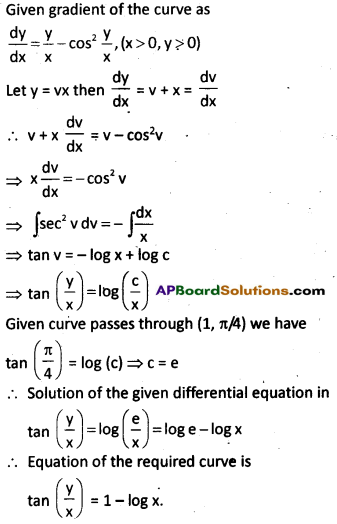Access to a variety of AP Inter 2nd Year Maths 2B Model Papers and AP Inter 2nd Year Maths 2B Question Paper May 2016 allows students to familiarize themselves with different question patterns.
AP Inter 2nd Year Maths 2B Question Paper May 2016
Time : 3 Hours
Max. Marks : 75
Note:
This question paper consists of THREE sections A, B and C.
Section – A
I. Very Short Answer Type questions.
- Attempt ALL the questions.
- Each question carries TWO marks.
Question 1.
If the length of the tangent from (5, 4) to the circle x2 + y2 + 2ky = 0 is 1, then find k.
Solution:
The length of the tangent from (x1, y2) to the circle x2 + y2 + 2gx + 2fy + c = 0 is \(\sqrt{\mathrm{s}_{11}}\)
The length of the tangent from (5, 4) to the circle
x2 + y2 + 2ky = 0 is 1
⇒ \(\sqrt{25+16+8 k}\) = 1
⇒ 8k = -40 k = -5.
Question 2.
Find the pole of ax + by + c = 0, (c ≠ 0) with respect to x2 + y2 = r2.
Solution:
Let (x1, y1) be the pole
Equation of the polar of (x1, y1) w.r.t. the circle
x2 + y2 = r2 is xx1 + yy1 = r2 ……….. (1)
but the given polar is ax + by + c = 0 …………… (2)
From (1) & (2)
∴ \(\frac{\mathrm{x}_1}{\mathrm{a}}\) = \(\frac{\mathrm{y}_1}{\mathrm{b}}\) = \(\frac{r^2}{-c}\)
Pole = (x1, y1) = \(\left(\frac{-a r^2}{c}, \frac{-b r^2}{c}\right)\)
![]()
Question 3.
Find the equation of the radical axis of the circles
x2 + y2 – 2x – 4y – 1 = 0
x2 + y2 – 4x – 6y + 5 = 0
Solution:
The equation of the radical axis of the circles
S = x2 + y2 – 2x – 4y – 1 = 0 and S1 = x2 + y2 – 4x – 6y + 5 = 0 is S – S1 = 0
⇒ (x2 + y2 – 2x – 4y – 1) – (x2 + y2 – 4x – 6y + 5) = 0
⇒ 2x + 2y – 6 = 0
⇒ x + y – 3 = 0
Question 4.
Find the equation of tangent to the parabola y2 = 16x inclined at an angle 60° with its axis.
Solution:
Given parabola is y2 = 16x ……… (1)
∴ Slope of the tangent is m = tan 60° = \(\sqrt{3}\)
The equation of the tangent to the parabola (1) having slope
\(\sqrt{3}\) is y = mx + \(\frac{a}{m}\)
⇒ y = \(\sqrt{3}\)x + \(\frac{4}{\sqrt{3}}\) = \(\frac{3 x+4}{\sqrt{3}}\) = \(\sqrt{3}\)y = 3x + 4
⇒ 3x – \(\sqrt{3}\)y = 0.
Question 5.
If the eccentricity of the hyperbola is \(\frac{5}{4}\), then find the eccentricity of the conjugate hyperbola.
Solution:
Let e and ex be the eccentricities of the hyperbola and its conjugate respectively
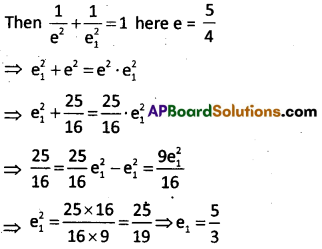
Question 6.
Evaluate the integral
\(\int \frac{(3 x+1)^2}{2 x}\)dx, x ∈ I ⊂ R/{0}
Solution:
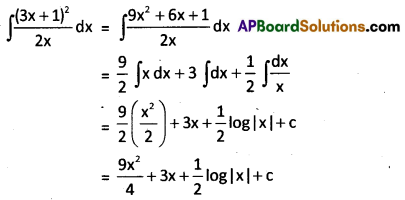
Question 7.
Evaluate the integral
∫ex (sec x + sec x tan x) dx
Solution:
We know that
∫ex (f(x) + f'(x))dx = exf(x) + c
∴ ex = [sec x + sec x tan x dx] = ex sec x + c
Question 8.
Evaluate the definite integral
\(\int_0^\pi \sqrt{2+2 \cos \theta}\) dθ
Solution:
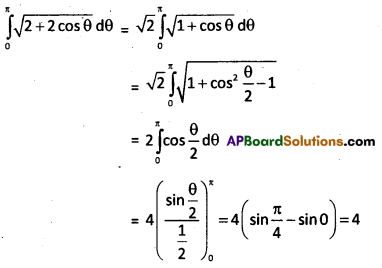
![]()
Question 9.
Evaluate the definite integral
\(\int_0^{\pi / 2} \sin ^6 x \cdot \cos ^4 x\) dx
Solution:
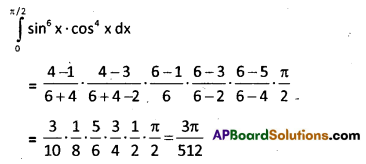
Question 10.
Find the general solution of x + y \(\frac{\mathrm{dy}}{\mathrm{dx}}\) = 0
Solution:
x + y\(\frac{d y}{d x}\) = 0 dx
y dy = -x dx
∫y dy = -∫x dx
⇒ \(\frac{y^2}{2}\) = \(\frac{-x^2}{2}\) + c ⇒ x2 + y2 = 2c.
Section – B
(5 × 4 = 20)
II. Short Answer Type questions.
- Attempt ANY FIVE questions.
- Each question carries FOUR marks.
Question 11.
Find the length of the chord intercepted by the circle x2 + y2 – x + 3y – 22z = 0 on the line y = x – 3.
Solution:
Given equation of circle is S = x2 + y2 – x + 3y – 22 = 0
Comparing with general equation S = 0 we get
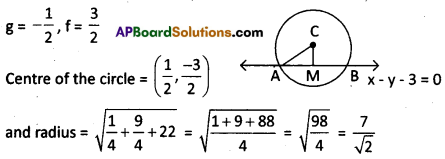
given line is y = x – 3 and L = x – y – 3 = 0
AB is the chord intercepted by the line L = 0 on the circle.
CM = Perpendicular distance from C\(\left(\frac{1}{2},-\frac{3}{2}\right)\) to x – y – 3 = 0
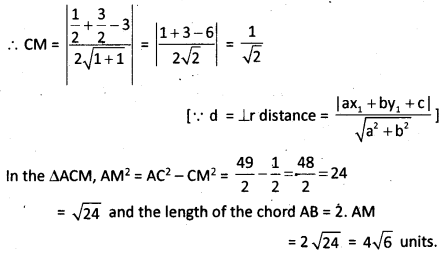
Question 12.
If x + y = 3 is the equation of the chord AB of the circle x2 + y2 – 2x + 4y – 8 = 0, find the equation of the circle having \(\overline{\mathrm{AB}}\) as diameter.
Solution:
Let S ≡ x2 + y2 – 2x + 4y – 8 = 0 be the given circle
Let L ≡ x + y – 3 = 0 be the given line
Given that L = 0 intersects the circle S = 0 at AB
Equation of the circle passing through the point of intersection of S = 0 and L = 0 is S + λL = 0 where λ is a constant
(x2 + y2 – 2x + 4y – 8) + λ(x + y – 3) = 0
⇒ x2 + y2 + (λ – 2) x + y (λ + 4) – (8 + 3λ) = 0 …….. (1)
Centre of the circle = \(\left[\left(\frac{\lambda-2}{2}\right),-\left(\frac{\lambda+4}{2}\right)\right]\)
Given that the line L = 0 is a diameter of the circle (1)
⇒ Centre \(\left(\frac{2-\lambda}{2},-\frac{\lambda+4}{2}\right)\) lies on the line x + y – 3 = 0
∴ \(\frac{2-\lambda}{2}\) + \(\left[-\left(\frac{\lambda+4}{2}\right)\right]\) – 3 = 0
⇒ -λ + 2 – λ – 4 – 6 = 0
⇒ -2λ – 8 = 0
⇒ 2λ = -8
⇒ λ = -4
∴ The equation of the required circle from (1) is
x2 + y2 + (-4 – 2) x + (-4 + 4) y – 8 – 3(-4) = 0
⇒ x2 + y2 – 6x + 4 = 0.
Question 13.
Find the equation of the ellipse with focus at (1, -1), e = \(\frac{2}{3}\) and directrix as x + y + 2 = 0.
Solution:
Given that focus S = (1, -1) and e = \(\frac{2}{3}\) and equation of directrix is L = x + y + 2 = 0
Let (x1, y1) be any point on the ellipse and PM is the perpendicular distance from P to the directrix L = 0.
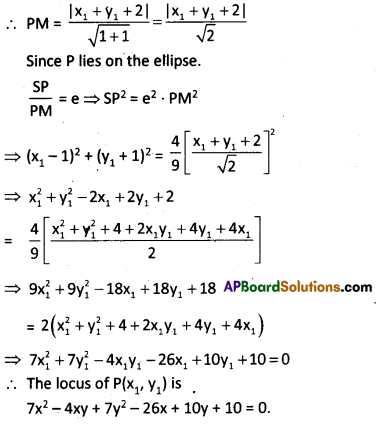
Question 14.
The tangent and normal to the ellipse x2 + 4y2 = 4 at a point P(θ) on its meets the major axis in Q and R respectively. If 0 < θ < \(\frac{\pi}{2}\) and QR = 2, then show that θ = cos-1\(\left(\frac{2}{3}\right)\)
Solution:
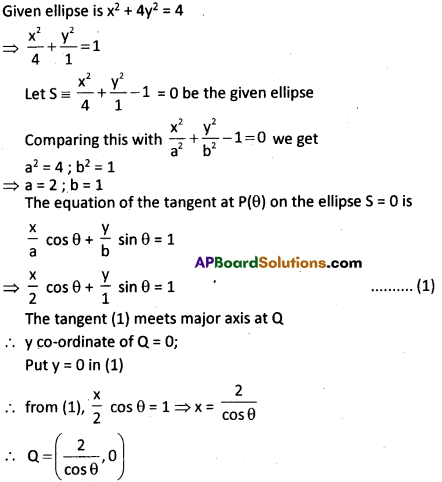
The equation of the tangent at P(θ) on the ellipse S = 0 is

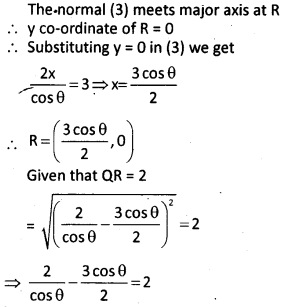
⇒ -3 cos2θ + 4 = 4 cos θ
⇒ 3cos2θ + 4 cos θ – 4 = 0
⇒ 3 cos θ(cos θ + 2) – 2(cos θ + 2) = 0
⇒ (cos θ + 2)(3cosθ – 2) = 0
∴ cos θ + 2 = 0: solution is not admissive (∵ -1 ≤ cos θ ≤ 1) and 3 cosθ – 2 = 0
⇒ cos θ = \(\frac{2}{3}\)
⇒ θ = cos-1 \(\left(\frac{2}{3}\right)\)
![]()
Question 15.
Find the centre, foci, eccentricity, equation of the directrices of the hyperbola x2 – 4y2 = 4.
Solution:
x2 – 4y2 = 4
This can be written as \(\frac{x^2}{4}\) – \(\frac{y^2}{1}\) = 1
⇒ a2 = 4 and b2 = 1
⇒ a = 2 and b = 1
i) centre – (0, 0)
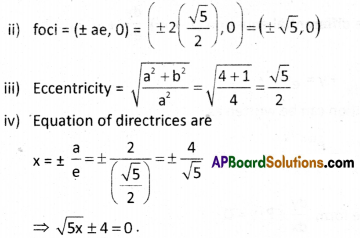
Question 16.
Find the area enclosed by the curves y = x2 + 1, y = 2x – 2, x = -1, x = 2
Solution:
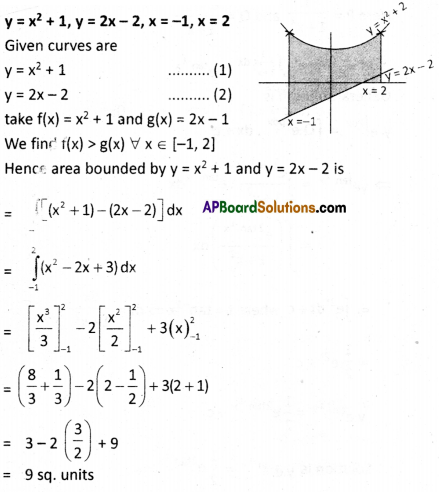
Question 17.
Solve the differential equation
![]()
Solution:
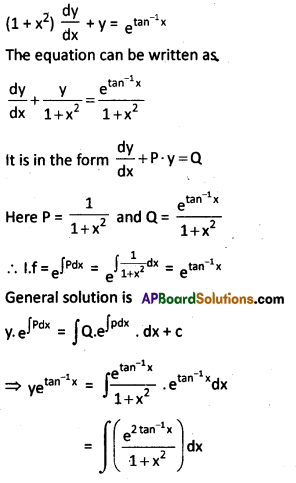
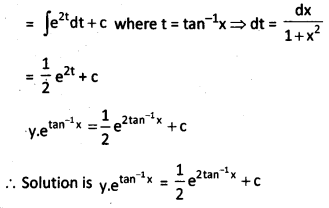
Section – C
III. Long Answer Type questions.
- Attempt ANY FIVE questions.
- Each question carries SEVEN marks.
Question 18.
Find the equation of circle passing through each of the three points (3, 4), (3, 2) and (1, 4).
Solution:
Let the equation of the required circle is
x2 + y2 + 2gx + 2fy + c = 0 …… (1)
Since (1) passes through the point (3, 4) then
(3)2 + (4)2 + 2g(3) + 2f(4) + c = 0
∴ 9 + 16 + 6g + 8f + c = 0 ⇒ 6g + 8f + c = -25 ……… (2)
Since (1) passes through the point (3, 2)
∴ 9 + 4 + 6g + 4f + c = 0 ⇒ 6g + 4f + c = -13 …….. (3)
Since (1) passes through the point (1,4)
∴ 1 + 16 + 2g + 8f + c = 0 ⇒ 2g + 8f + c = -17 …….. (4)
from (2) & (3)
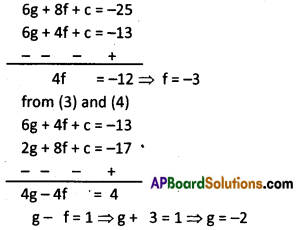
Substitute the value of g, f in (2)
6(-2) + 8(-3) + c = -25
-12 – 24 + c = -25 ⇒ c = -25 + 36
∴ c = 11
Substitute the values of g, f, c in (1)
x2 + y2 + 2(-2) x + 2 (-3) y + 11 = 0
= x2 + y2 – 4x – 6y + 11 = 0
∴ The equation of the required circle is
x2 + y2 – 4x – 6y + 11 = 0
Question 19.
Show that the circles x2 + y2 – 6x – 2y + 1 = 0, x2 + y2 + 2x – 8y + 13 = 0, touch each other. Find the point of contact and the equation of common tangent at their point of contact.
Solution:
Let S ≡ x2 + y2 – 6x – 2y +1 = 0 and
S’ ≡ x2 + y2 + 2x – 8y + 13 = 0 be the given circles then centre of circles are C1 = (3, 1) and C2 = (-1, 4)
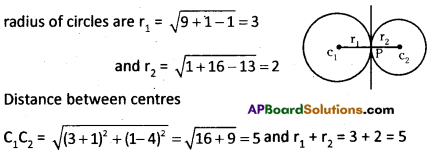
Since C1C2 = r1 + r2 the two circles touch externally at a point at P be the point of contact of circles such that r1: r2 = 3 : 2
Since P divides C1, C2 internally in the ratio 3 : 2 coordinates of point of contact
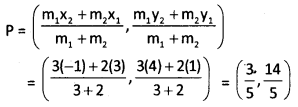
The equation of common tangent is S – S’ = 0
⇒ x2 + y2 – 6x – 2y + 1 – x2 – y2 – 2x + 8y + 13 = 0
⇒ -8x + 6y – 12 = 0
⇒ 4x – 3y + 6 = 0
∴ The equation of the common tangent at the point of contact is 4x – 3y + 6 = 0
Question 20.
Find the equation of the parabola whose axis is parallel to X-axis and which passes through the points (-2,1), (1, 2) and (-1, 3).
Solution:
Let A = (-2, 1), B (1, 2) and C = (-1, 3) be the given points.
Let the equation of the parabola whose axis is parallel to X – axis and passing through the points A, B, C be
x = ly2 + my + n ……. (1)
If parabola (1) passes through A(-2, 1) then
-2 = l + m + n ………. (2)
If (1) passes through B(1, 2) then 1 = 4l + 2m + n …….. (3)
If (1) passes through C (-1, 3) then -1 = 9l + 3m + n …….. (4)
From (2) and (3)
-3l – m = -3 ⇒ 3l + m = 3 …….. (5)
From (3) and (4)
-5l – m = 2 = 5l + m = -2 ………. (6)
Solving (5) and (6) we get
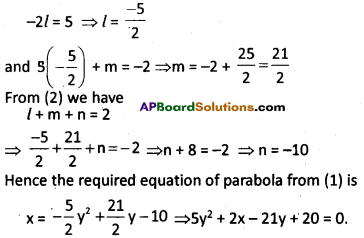
Question 21.
Evaluate the integral
\(\int_0^\pi \frac{x \sin x}{1+\cos ^2 x}\)dx
Solution:
We write x + 1 = A\(\frac{d}{d x}\)(x2 + 3x + 12) + B = A (2x + 3) + B
On comparing the coefficients of like powers of x on both sides of the above equation, we get
2A = 1 ⇒ A = \(\frac{1}{2}\) and 3A + B = 1
⇒ B = 1 – 3A = 1 – \(\frac{3}{2}\) = –\(\frac{1}{2}\)
A = \(\frac{1}{2}\) and B = –\(\frac{1}{2}\)
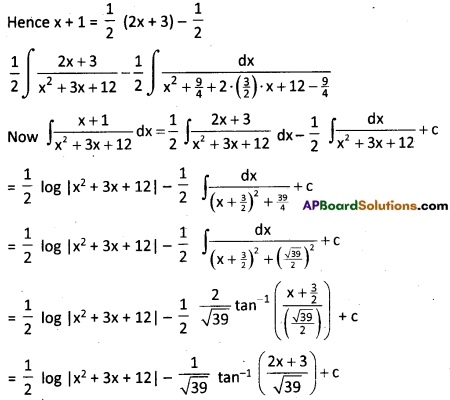
![]()
Question 22.
Obtain the reduction formula for ∫ tannx dx for an integer n ≥ 2 and deduce the value of ∫ tan6x dx.
Solution:
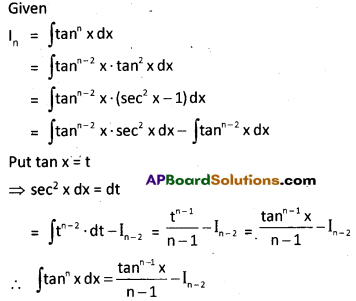
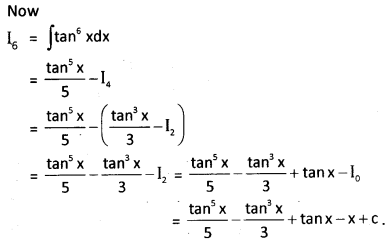
Question 23.
Evaluate the integral
\(\int_0^\pi \frac{x \sin x}{1+\cos ^2 x}\)dx
Solution:
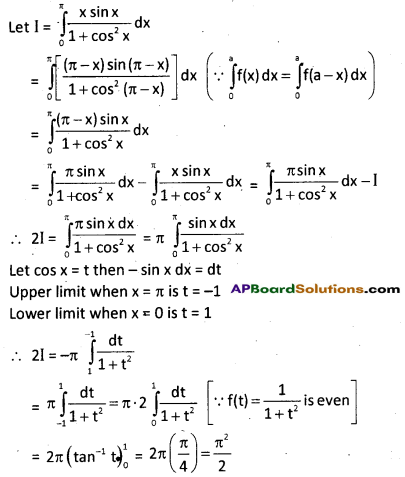
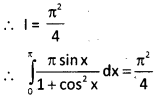
Question 24.
Find the equation ofa curve whose gradient is \(\frac{d y}{d x}\) = \(\frac{y}{x}\) – cos2 \(\left(\frac{y}{x}\right)\) where x >0, y > 0 and which passes through the point (1, \(\frac{\pi}{4}\))
Solution:
